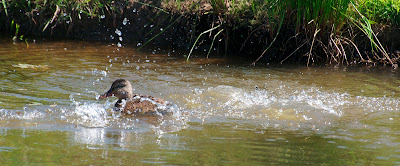 My wife and I walked the perimeter of TRNWR this past Sunday afternoon. It was a beautiful day, but other than a huge flock of Bushtits and a Cooper's Hawk, things were pretty slow. On the home stretch along the south canal, we came upon five Mallards. I believe they were all adult females as we had passed both a female with ducklings and a group juveniles further back.
My wife and I walked the perimeter of TRNWR this past Sunday afternoon. It was a beautiful day, but other than a huge flock of Bushtits and a Cooper's Hawk, things were pretty slow. On the home stretch along the south canal, we came upon five Mallards. I believe they were all adult females as we had passed both a female with ducklings and a group juveniles further back.
They exhibited both interesting behavior and characteristics. Quite often one would start to flap its wings very fast, slapping the water and raising quite a raucous as seen above.
 At other times they would completely dive under water for short periods instead of dabbling like a typical Mallard. I didn't get a picture of one diving, but you can see the splash aftermath of one that had just dove on the right side of the image above.
At other times they would completely dive under water for short periods instead of dabbling like a typical Mallard. I didn't get a picture of one diving, but you can see the splash aftermath of one that had just dove on the right side of the image above.
 Then I noticed something else interesting, most of these birds were missing most of their primary and secondary feathers on their wings. As you can see above, the rump of this bird is not covered with its wing's primary feathers as you would typically see them.
Then I noticed something else interesting, most of these birds were missing most of their primary and secondary feathers on their wings. As you can see above, the rump of this bird is not covered with its wing's primary feathers as you would typically see them.
 I started taking pictures of any of the ducks that flapped it's wings in hopes of getting some good views of the condition of their feathers. The one above is missing most all of its wing feathers.
I started taking pictures of any of the ducks that flapped it's wings in hopes of getting some good views of the condition of their feathers. The one above is missing most all of its wing feathers.

 Finally, there is this one. Its wings appear to be fairly filled out.
Finally, there is this one. Its wings appear to be fairly filled out.
So why are there what appear to be adult Mallards without wing feathers? I had already read that many water fowl molt after breeding and for a while can be flightless. After doing a bit more research, I found that male Mallards molt shortly after breeding and take on plumage similar to a female called the eclipse phase. Females will molt a bit later after its ducklings have fledged. I believe this is the case with these birds.
I could not find any pictures on the web similar to these, so I suppose these could be juveniles that haven't fully feathered out, but since they seem to have adult plumage other than on their wings, I suspect that these are adults going through their summer molt.
I welcome comments that either agree or disagree. And don't forget to say why!


No comments:
Post a Comment